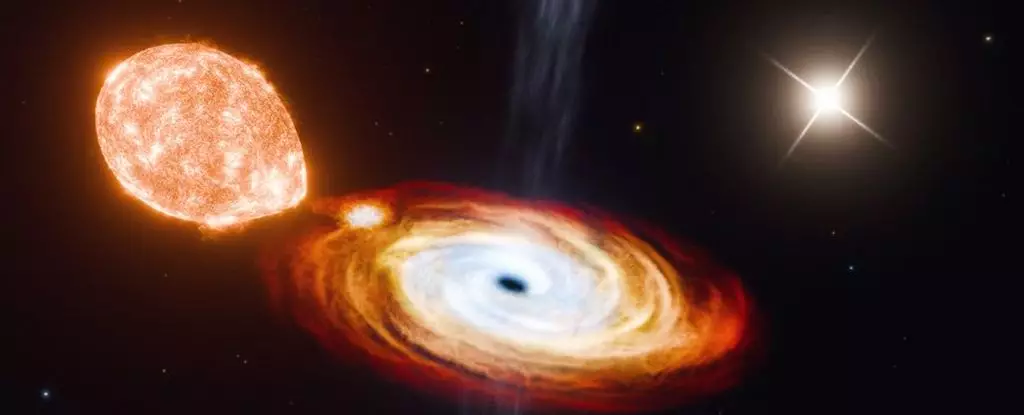Deep within the constellation Cygnus, approximately 7,800 light-years from our planet, resides one of the universe’s most captivating phenomena: the black hole system known as V404 Cygni. Renowned for its peculiar behavior, this system has recently surprised astronomers again by revealing a hidden trinary composition. While it has long been known that V404 Cygni has a companion star orbiting it every 6.5 days, the discovery of a third celestial body, which orbits at an impressive distance and takes around 70,000 years to complete one revolution, raises intriguing questions about the mechanisms behind black hole formation and evolution. This newfound complexity has not only excited scientists but has also provided fertile ground for re-evaluating existing theories about black hole dynamics and the processes that lead to their formation.
Reassessing Stellar Evolution Theories
Traditionally, it was believed that black holes formed through explosive supernova events—the cataclysmic collapse of a massive star that ejects its outer layers, leaving behind a dense core that succumbs to the force of gravity. Recent insights gleaned from V404 Cygni challenge this widely-accepted theory. The supernova model, while supported by substantial observational data, is now under scrutiny owing to the existence of this third companion star. Kevin Burdge, a physicist from MIT, articulated this tension by stating that this discovery necessitates a reevaluation of the conditions under which black holes may arise. Particularly, the notion that black holes form through direct collapse—a process in which a star implodes without generating the chaotic aftermath of a supernova—gains momentum in this context.
Gaia Mission: A Game Changer in Cosmic Exploration
The revelation of V404 Cygni’s unique structure owes much to data collected by the European Space Agency’s Gaia mission, which aims to map the Milky Way’s three-dimensional architecture. Gaia not only provides data on the positions of celestial objects but also tracks their velocities and trajectories, illuminating underlying connections between them. In the case of V404 Cygni, measurements revealed that both the black hole and its previously recognized companion star share a common velocity and direction, indicating a gravitational tether that links them over vast distances. This finding leads to the compelling conclusion that V404 Cygni truly constitutes a trinary system, prompting scientists to ask how such connections can survive in a universe rife with explosive events.
The Challenges of Supernova Dynamics
Empirical evidence for the supernova mechanism is abundantly clear; however, the particular characteristics of V404 Cygni create a set of contradictions that are difficult to resolve. In supernova events, if the explosion is not perfectly symmetrical, it can produce an imbalance enough to give the newly-formed black hole a momentum push. Given the vast distance of 3,500 astronomical units between the black hole and the third star in this system, such a kick would likely disrupt any existing gravitational link. This presents a conundrum for researchers: if a supernova explosion had indeed occurred, speculation arises as to why the components of this system remain bound together.
Burdge and his colleagues engaged in extensive simulations, running thousands of scenarios to try and understand the evolution of this system. Their findings consistently pointed toward direct collapse as the most probable explanation for the existence of the trinary configuration. This hypothesis challenges longstanding conventions and suggests that many black holes may have formed in such direct, less chaotic manners. If validated, the existence of systems like V404 Cygni could pave the way for understanding other “invisible” black holes that might exist elsewhere in the cosmos and that have not yet been detected.
The discovery of V404 Cygni’s trinary structure has opened a new lens through which to examine black hole formation and the potential existence of additional wide-ranging black hole-inclusive trinary systems. As astronomer Kareem El-Badry from Caltech noted, finding such configurations could yield answers to longstanding questions about binary black holes’ evolution and even provide clues for why certain black holes undergo direct collapse rather than a traditional explosion. If these trinary systems are commonplace, our understanding of the life cycles of stars, black holes, and the gravitational forces that govern them may see a paradigm shift.
The search for further examples of such complexes has begun, promising new revelations about the dynamic nature of our universe. As telescopes and space missions continue to enhance our observational capabilities, the mysteries of black hole systems, like V404 Cygni, reveal themselves tantalizingly, inviting scientists and enthusiasts alike to question what we know about the cosmos and the forces that shape it.

